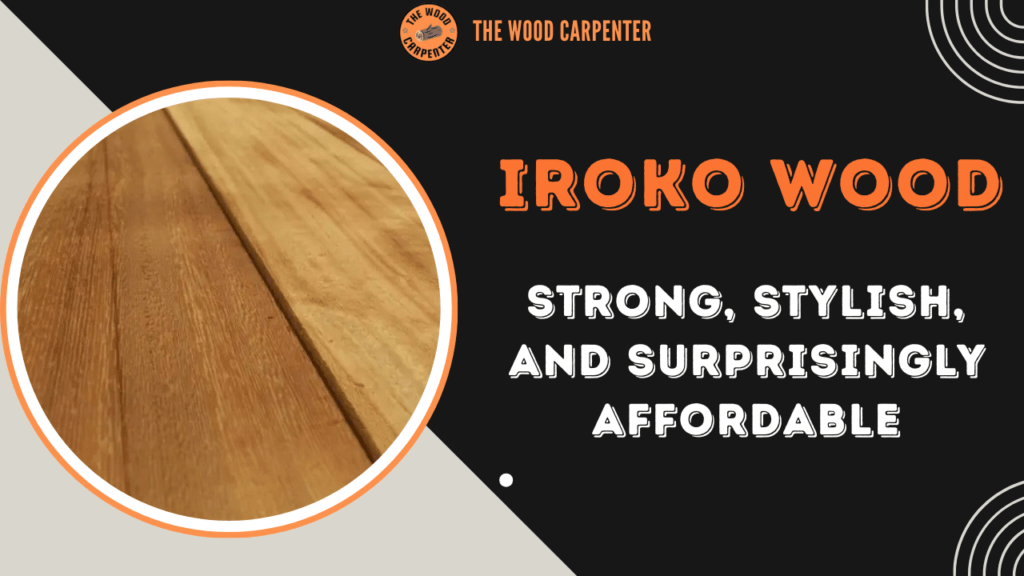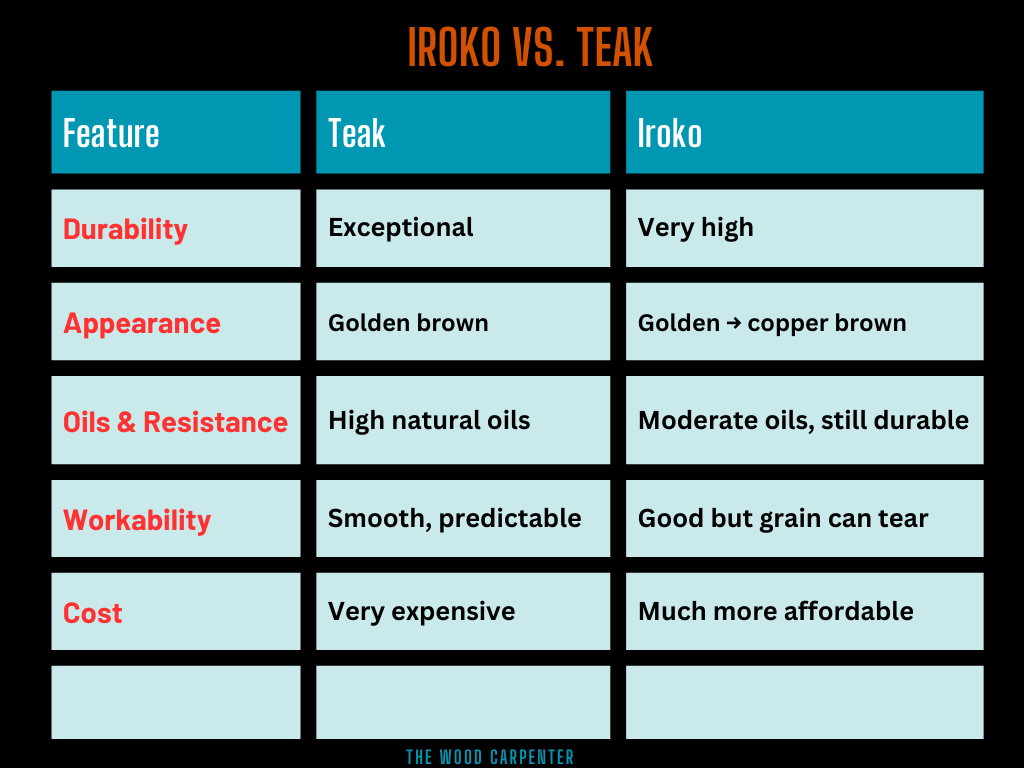
If the warm golden tones of teak but its high price are keeping you away, let me introduce Iroko wood as an attractive alternative: often known as African Teak it has earned itself a place as one of the world’s most versatile, durable, and cost-effective hardwoods.
I first discovered Iroko while shopping for decking options. A supplier brought out a honey-colored plank and told me, “This is Iroko. Think of it as the tougher cousin to teak that won’t empty your wallet.” That statement intrigued me, and so began my investigation into this unique wood. What I discovered is that its popularity warrants inclusion in workshops, homes and boats worldwide.
We will cover everything you need to know about iroko wood in this guide: its origin, properties, uses, strengths and quirks as well as why many woodworkers vouch for its qualities.
What Is Iroko Wood?
Iroko comes from two trees from the Milicia genus — Milicia excelsa and Milicia regia–native to tropical Africa with trees reaching 30-40 meters (100-130 feet). Some may live up to 500 years!
Locally known by names such as odum, uloho and iroko trees are recognized for producing timber with extraordinary durability and natural beauty. With golden to medium brown tones that often remind people of teak wood–hence the name African Teak — Iroko has quickly earned global renown as an internationally respected choice.
Appearance and Grain
Newly milled iroko has an elegant golden-yellow heartwood that gradually darkens to rich copper or medium brown tones with age. If left outdoors without treatment, the wood eventually develops its hallmark silvery-grey patina that many designers prefer for coastal or rustic settings.
Quarter-sawn boards feature interlocked grain that creates an appealing ribbon effect; however, this interlocking can make machine cleaning difficult, often leading to tearout of boards. Their texture ranges from medium-fine to coarse with large pores that add character.
Strength, Hardness, and Stability
One of the hallmark qualities of Iroko wood is its remarkable balance between strength and workability.
- Density: ~660 kg/m³ (about 41 lb/ft³)
- Janka Hardness: 1,190–1,260 lbf (similar to teak and oak)
- Modulus of Rupture: ~14,000 psi
- Crushing Strength: ~7,750 psi
Simply put, iroko wood is tough enough to withstand years of heavy use without becoming intractable for your tools. Additionally, its oily nature helps it resist water absorption and movement resulting in dimensional stability – no warping, shrinking, or swelling is an issue with this wood species.
Boatbuilders, flooring specialists and furniture makers all rely heavily on Iroko wood due to its stability.
Durability and Outdoor Performance
Here’s where iroko really shines: natural durability.
It resists rot, fungal decay, and insect attack better than many hardwoods. This means you can use it outdoors—decking, cladding, garden furniture, docks, even boat parts—without constantly worrying about preservatives.
However, if you appreciate its golden hue, make sure it stays rich with UV-protective oil or finish to preserve its richness. Otherwise, exposure to sunlight can eventually turn it silver-grey over time.
Personally I like weathered looks; if investing in polished furniture or decks however an oil finish would protect the richness and maintain the richness of its color.
Workability: The Good and the Tricky
Working with Iroko can be like cooking with chili peppers–it requires patience but penalizes shortcuts.
- Pros:
- Easy to plane, turn, and mould with sharp tools.
- Glues, nails and screws work reasonably well.
- Takes finishes beautifully if prepped correctly..
- Cons:
- Interlocked grain may lead to tear-out when planing.
- Deposits of calcium carbonate (mineral streaks) may blunt blades.
- Natural oils can impede finishes unless surfaces are first treated with methylated spirits, for instance.
Tip from the pros: to achieve stunning results when it comes to machining, keep tools sharp and don’t rush the process. When done right, results can be jaw-droppingly beautiful.
Common Uses of Iroko
Because it combines durability, beauty, and affordability, iroko is widely used in both indoor and outdoor projects – from flooring applications to patio furniture designs. You may come across it in:
- Decking and cladding – A teak alternative that holds up in the elements.
- Furniture – From elegant dining tables to outdoor benches.
- Flooring – Stable underfoot and visually warm.
- Boatbuilding – A longtime favorite for marine applications.
- Cabinetry and joinery – Wide boards make it millwork-friendly.
- Turned items – Bowls, handles, and specialty pieces.
Iroko vs. Teak: How Do They Compare?
Teak may have long been considered the benchmark of outdoor hardwoods, but Iroko holds its own in many respects:

In short, if teak is out of your budget, iroko is a smart, reliable substitute.
Sustainability and Sourcing
Iroko trees may not be listed under CITES, but their sustainability remains a serious issue. Milicia excelsa is classified by IUCN as Near Threatened while Milicia regia is more vulnerable.
What this means for buyers: Be sure that your iroko comes from responsibly managed forests, like Duffield Timber or McIlvain who prioritize legal and sustainable harvesting methods.
Finishing Tips
- Leave it natural for a silver-grey weathered look.
- Apply oil finishes (like clear UV oils) if you want to maintain the golden brown tones.
- Always wipe down with spirits before finishing to remove oily residues.
- Expect variation—boards may differ in shade, adding to the charm.
Final Thoughts
Iroko wood is more than just an economical teak alternative–it stands out as an exceptional hardwood in its own right. Durable, versatile, and beautiful–Iroko offers all of the strength and beauty associated with exotic tropical woods at more manageable costs.
No matter if it’s for deck construction, furniture creation or boat restoration iroko deserves serious consideration. I know I will certainly continue using it as there’s something deeply satisfying in working with a wood that balances beauty with practicality and longevity so well.
FAQs About Iroko Wood
1. Is iroko wood expensive?
No. Compared to teak, iroko is much more affordable, though still pricier than softwoods.
2. Is iroko good for outdoor use?
Yes. Its natural resistance to rot and insects makes it excellent for decking, cladding, and garden furniture.
3. Does iroko need treating?
Not for durability. However, applying a UV oil will help preserve its golden colour instead of letting it fade to grey.
4. Is iroko safe to work with?
Mostly, yes. But iroko dust can cause irritation or allergic reactions in sensitive individuals—so always wear a mask and use dust extraction.
5. How does iroko compare to teak?
It’s similar in durability and appearance but more affordable. The main difference is that teak is slightly more oily and easier to work with.

